Lieutenant de Erauso, the Mercenary Nun
Catalina de Erauso was a real person, that much we can verify. The details of her life, however, are much harder to pin down. Partially this is because our main source is her “autobiography”, which reads like an adventure novel and probably was one. But partially this is because Catalina’s real exploits were so outrageous that people found it difficult to credit them, even though they actually happened. So fact becomes impossible to distinguish from fiction, and legends are born. [1]
When this particular legend was born is actually where the confusion starts, as it happens. Her autobiography says that she was born in 1585, but records of her baptism give a date of 1592. Since she was enrolled in a convent as a four year old, it seems unlikely she wasn’t baptised until she was seven. [2] Her aunt was the prioress of the convent, and Catalina’s two sisters were also sent there – not unusual for educating the children of the well-off. The convent was in the town of Donostia (also known as San Sebastian), in the Basque district of Spain. Her father was an officer in the Spanish army, and from an early age Catalina wanted nothing more than to also be a soldier. Of course in the deeply conservative Spanish society of the time, such a thing was unthinkable.
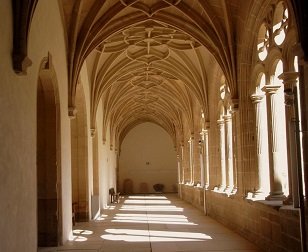
Normally a marriage would have been arranged for the children in the convent once they were old enough, but Catalina’s rebellious temperament convinced her parents that it was useless to try and get her a husband. Instead she was confined to the monastery of San Bartolome, and it was decided that she would become a nun. Of course Catalina was not consulted on this, and she had no intention of meekly going along with it. Beatings from the nuns for her insolence didn’t change her mind, and at the age of 15 she finally managed to escape from the convent. She cut her hair and altered her clothing to appear masculine, and headed out on the road.
Catalina’s sexuality is pretty hard to pin down. She was probably either a lesbian (she made no secret of her attraction to women, and was never romantically involved with any men) or possibly a trans man. Her autobiography is ambiguous on the matter, though given the attitudes of the times it could hardly directly state she was trans. Instead it varies its pronouns in an interesting manner, taking advantage of how personal pronouns in Spanish have gender. In the book Catalina uses the female pronouns for the periods in her life when she was publicly identified as female, and male pronouns for when he was publicly identified as male. [3] He used a variety of names throughout this period (Pedro, Francisco, Alonso, Antonio), and doesn’t seem to have settled on one. (This is why we are using his birth name for this article. No disrespect is intended.) He didn’t have to bind his chest, as he was naturally flat-chested, though he later mentioned using some kind of herbal remedy to reduce his bosom as well.
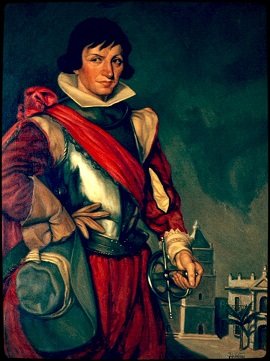
This masculine disguise seems to have started as a way to escape pursuit from the convent, but circumstances soon taught Catalina that it was a wise precaution in general. The first man who took him in was a doctor (who was married to a relative of hers) who soon tried to sexually abuse him. Catalina left, but not before cleaning out the doctor’s spare cash. He continued to wander around Spain, perfecting his disguise and finding employment as a page boy in various households. An encounter with his father (who was searching for him, but failed to see through his disguise) rattled his confidence, while a spell in jail for fighting nearly exposed his secret. At the time, cross-dressing was illegal in Spain and carried serious penalties. Perhaps it was to test his confidence that Catalina returned to San Sebastien for a while, where he deliberately met his relatives and wasn’t recognised. This may have been down to the success of his transformation, or may simply have been because he’d spent his earlier life ensconced in the convent. After this trial of fire he decided to leave Spain behind. At the age of 18, like so many Spanish people, Catalina headed off to the Americas to seek his fortune.
At the time the Spanish were busy building what would become in time the largest empire in the world, stretching across what is now South America. It was the source of most of the wealth of Spain, which at the time was at war on multiple fronts and needed all the money it could get. It was the land of opportunity, and it was the perfect place for Catalina to make his mark. The ship she sailed on was captained by one of his mother’s relatives, who (like everyone else) failed to recognise him. When the ship was due to return to Spain, Catalina stole what cash he could find (possibly shooting the captain in the process) and jumped ship, heading for adventure.
Catalina passed through Panama having various adventures, and eventually fetched up in modern day Peru, on the western coast of the Empire. There he found employment working for a local merchant. Catalina seems to have been a fairly personable fellow, as he never had any difficulty finding work and seems to have aways done well at it. In this case he became a favourite of his employer, though his quick temper soon got him in trouble. He got into a fight with a young man at the theatre, and only after Catalina had cut his face and left him scarred did he find out that he was the nephew of his master’s mistress. He was offered two alternatives, either marry the mistress (in order to help her master keep up a respectable charade), or leave the city. As the mistress (who had no idea of Catalina’s secret) made no secret of her relish for bedding the dashing young man, Catalina chose the latter in order to preserve his disguise. Off he went to manage a store in Trujillo on the coast. The young man and two of his friends decided to come out there after Catalina and teach him a lesson, one he was more than willing to return. One of the friends was killed, and Catalina wound up in jail again. His old master managed to get him released, but he had to move on once more.
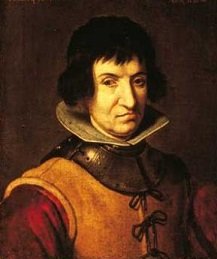
Catalina’s next job was in Lima, where he managed a shop for nine months before he was fired. The reason? He was caught in an amorous embrace with his boss’s sister in law, “running his hand between her legs”. His disreputable behaviour led to immediate dismissal. This time Catalina had no letter of recommendation to get a new job, so he decided instead to join the army. There was always a demand for soldiers in Chile, as the Mapuche there were one of the few native peoples who had managed to resist Spanish conquest. Catalina headed off to war against them in 1619. It is here that his adventures become a lot better documented, due to the military records, though he did still use a fake name of course.
Catalina gained a reputation for brutality during his time in the military, though the efficiency he combined it with impressed his superiors. One of those superiors was his brother, Don Miguel de Erauso, who was the secretary of the governor and who didn’t recognise Catalina. After three years Catalina reached the rank of second lieutenant, but also made himself unwelcome in the city due to his temper. At one stage the captain of his company was killed and he took command, winning an important battle in Puren. However his “take no prisoners” attitude got him in trouble as after the battle he killed one of the Mapuche leaders who the army had been ordered to take alive. As a result he wasn’t granted a permanent captaincy, but instead was suspended from duty on half-pay.
Back in Concepcion his boredom (and residual battle trauma) led him to drink and gamble to excess, and on one of these debauchs he got into a fight and almost killed a man in a brawl. Rather than face a court martial, he took sanctuary in a church attached to a Franciscan monastery. He wound up staying there for six months until he was asked by another officer to serve as a second in a duel. The duel took place in a dark alley, and when it began Catalina got into a fight with the second of the other participant. Only after he’d killed him did he realise that it was his brother Miguel. Catalina fled back to the monastery, where he watched from the gallery as his brother’s body was brought in and laid out.
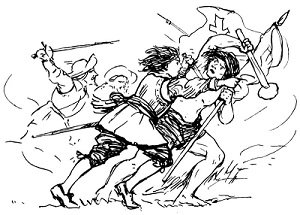
Filled with guilt and grief, he decided to desert from the army. He joined up with a couple of other deserters and headed up north, but wound up hopelessly lost in the Andes. The other two men starved to death, and Catalina nearly followed them but was found by a pair of farm hands in the nick of time. He was taken back to the ranch and nursed back to health by the owner, a Native American widow. The widow then proposed that Catalina marry her daughter. Though Catalina found the daughter unattractive, he agreed to marry her in order to avoid confrontation. While ostensibly arranging the marriage, Catalina courted the daughter of a local lay official and proposed to her as well. Before either marriage could take place, Catalina stole the dowries and went back on the run.
Over the next year Catalina soon gained a reputation as a travelling conman and brigand, with a fast temper and a sword blade to match. His adventures during this time make up the bulk of his autobiography (and are probably the most fictional part of it). According to the text, he got into more than one fight and killed more than one man, and in one case was caught and condemned to hang. However the only witness against him was himself captured and sentenced to death for a different crime, and decided to clear Catalina before he was executed. On another occasion Catalina found himself drawn into helping a wife flee her husband, after he had caught her in bed with another man. The cuckold had killed the wife’s lover and now planned to kill her too. Catalina helped her escape, and the grateful woman managed to get him a job as a bounty hunter. His one commission was extremely successful, but before he could get a second he got into a fight with a servant of a local judge and wound up stabbing and killing him. Catalina was sentenced to death, but managed to avoid execution by a clever ruse. During his confession and final Mass, he spat the communion into his hand and then appealed for sanctuary. The church dogma said that the Host had to be brought back into the tabernacle, and so when he was brought there to have it scraped off his hand he was within the area of the altar where sanctuary applied. Catalina spent a month in the church, but eventually the governor stopped guarding it and he escaped into the wilds.
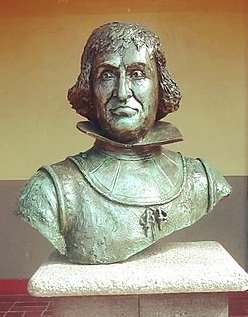
Continuing on his odyssey, Catalina joined a militia in Lima that was defending the city’s port at Callao from attack by the Dutch. Catalina was captured when his ship was sunk, but luckily for her the death of the Dutch admiral Jacques l’Hermite from dysentery led to them breaking off their attack. He and the other prisoners were abandoned on the coast a hundred miles from Lima, but he managed to make his way back to the city. From there he headed to Cuczo, where he had a run in with a local gang leader who called himself “the new Cid” (after the famous Spanish hero). Catalina was gambling and winning, but “el Cid” felt that he was entitled to reach in and take a portion of Catalina’s winnings when his stack grew too large. The third time he tried it, Catalina nailed his hand to the table with a dagger. His gang didn’t take kindly to this, and Catalina barely made it out of the gambling den in one piece. “El Cid” followed, and a fight commenced. True to his namesake, the gang leader wore a set of armour but Catalina still managed to take him down. However Catalina was also badly injured and the assumption was that he was going to die. He gave his last confession to a local priest, telling the entire story of his life from San Sebastien to Cuczo. The priest was shocked, but respected the seal of the confessional and didn’t breathe a word after Catalina made an unexpected recovery.
Things were getting a touch hot for Catalina by now. He was a wanted man, and posters bearing his face had been distributed throughout the area. In Ayacucho he barely escaped arrest and managed to find sanctuary with the local Bishop, Francisco Verdugo Cabrera. Perhaps in order to escape from this pursuit, Catalina decided to come clean with the churchman. He told him:
Sir, all this I have told your Lordship is not so. The truth is this: that I am a woman; that I was born in such-and-such a place, daughter of such-and-such man and woman; that I was placed at a certain age in such-and-such a convent with my aunt so-and-so; that I grew up there, took the habit and became a novice; that, about to take the vows, I ran off; that I went to such-and-such a place, stripped, dressed myself as a man, cut off my hair, travelled here and there, went to sea, roamed, hustled, corrupted, maimed, and murdered, until coming to end up here at his Lordship’s feet.
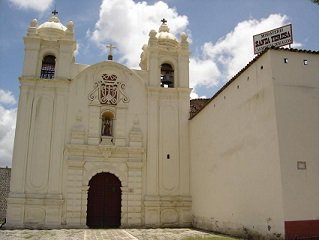
The bishop was utterly astonished by this, but when an examination of Catalina by a pair of midwives revealed both the truth of the story and her still intact virginity, he was convinced. It was that virginity which probably saved her, as it made her still “respectable” in the eyes of the church. She was placed in a nun’s habit, and became a local sensation. The church officials planned to have her enter a convent, but Catalina was no more willing to do this than she had been as a teenager. According to her autobiography, it wasn’t until word came back from Spain that she had, as she said, never actually taken her vows that she was allowed to leave the convent.
Catalina made her way back to Spain, where she was the subject of a great deal of public interest. She made a petition to the king for a military pension for her service in Chile, though this took some time to authenticate as she had been using an alias at the time. It’s from these petitions that we get the most verifiable information about her. Eventually the king decided to grant her a pension of 800 pesos a year. She also gained an amnesty from the laws against wearing male clothing. Her autobiography claims that this was due to an exemption granted by the Pope himself after she was presented to him and told him her story. It was around this time that she dictated her autobiography La Monja Alferez, “Lieutenant Nun” (if she did have a hand in it, and it wasn’t a later fiction) as this is where it ends. In 1630 Catalina was painted by Juan van der Hamen, and the same year she returned to the Americas and settled in Mexico. She had one last escapade on the trip over as she had been hired to be the bodyguard of a girl being sent to Mexico to be wed. Catalina fell in love with the girl she was transporting, and almost challenged the prospective husband to a duel, but she was convinced not to do so Once she arrived she used her pension to set up a business as a mule driver, transporting cargo between Veracruz and Mexico City. She got a reputation as a local character, as he still dressed as a man. She died twenty years later in 1650, reportedly of a heart attack.
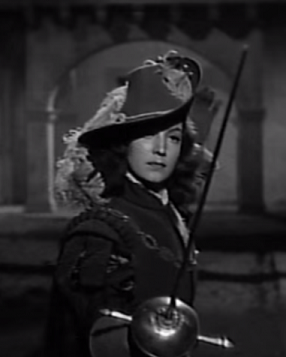
Catalina’s autobiography was reportedly first published in 1625 though none of those original editions survived. The manuscript resurfaced in 1784 in the official state chronicles of the Spanish Indies, and in 1815 it came to the attention of the historian and politician Joaquin Maria de Ferrer. He had been a military officer in Peru himself, and so he was captivated enough by Catalina’s story to publish it. De Ferrer was aware of how fantastical the tale seemed, and spent the next fourteen years researching Catalina’s history in his spare time in order to provide a great deal of supporting material to prove her existence. The book was published in France in 1829 under the title of The Nun Lieutenant. [4] It was partially translated into English in 1840, though it wasn’t until 1908 that a full translation was available. The story of Catalina was as compelling then as it had been during her life, and though he remains an undeservedly obscure figure there have been several plays and movies based on the nun who became a soldier. She was hardly the nicest of people – by his own admission she was a murderer and a wastrel. But he lived her own life as his own true self, and never compromised on that identity. And that’s something that always deserves your respect.
Images via wikimedia except where stated.
[1] In other words, break out the big grain of salt.
[2] Laws against adult baptism in deeply Catholic Spain would also have meant that she’d have been baptised a lot younger than that.
[3] I’ve chosen to follow suit.
[4] At the time Joaquin was actually living in exile in London. He returned to Spain in 1833 and wound up becoming Prime Minister in 1841.
